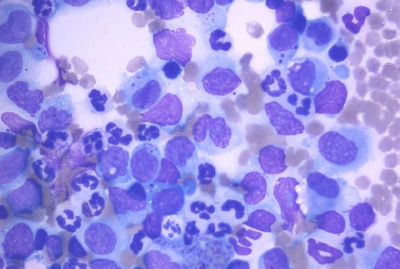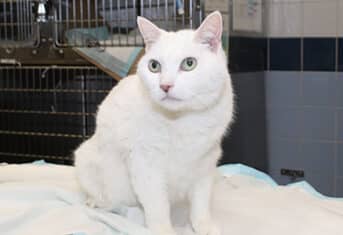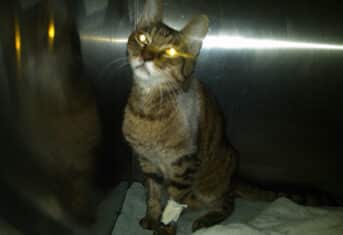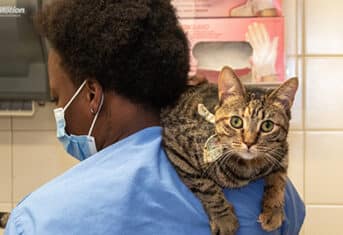Feline Lymphoma: What You Need to Know

Feline Lymphoma: What You Need to Know
June is Adopt a Shelter Cat Month and we’re highlighting our feline friends throughout the month through a series of feline-focused posts. Last week, I wrote about caring for mature and senior cats. This week, I’ll discuss the most common type of cancer diagnosed and treated in cats: lymphoma.
What is Lymphoma?
Lymphoma is cancer of the immune system. The immune system is distributed throughout the body to protect against infections. Lymphoma in cats most commonly affects the gastrointestinal tract, although since the immune system is distributed throughout the body, lymphoma can be seen in any organ in the body including the eyes, in front of the heart, and in the kidneys, liver or spleen. Unlike canine lymphoma, feline lymphoma rarely occurs in the lymph nodes.
In cats (and also humans and dogs) it is not a single disease but is probably more than 20 different diseases; each of the 20 or so forms of lymphoma behaves somewhat differently and the prognosis varies between types. The most common form of lymphoma we see in cat intestines is called small cell lymphoma. We also see an intestinal variant called large cell lymphoma. The photomicrograph accompanying this blogpost shows a rare form of feline lymphoma called large granular lymphoma. The name comes from the granules seen in some of the cancerous lymphocytes.
How is Lymphoma Treated?
Three major types of treatments underlie all cancer therapy: surgery, radiation therapy and chemotherapy. Since lymphoma is widespread throughout the body at the time of diagnosis, surgery is generally not an option as removal of all the lymph tissue in the body is impossible. However, a solitary mass of lymphoma may sometimes be removed from the intestine if the mass is causing problems for the cat. Surgery may also be recommended to obtain a biopsy for diagnosis. Radiation therapy can be used in select cases of feline lymphoma, especially if chemotherapy stops working. However, chemotherapy remains the mainstay of feline lymphoma treatment.
Multiple Chemotherapy Protocols for Feline Lymphoma
In my office, I have a big fat folder of articles describing various chemotherapy protocols for the treatment of lymphoma. Many of them are simply a riff on a theme. In my experience as a pet cancer specialist, there are three basic options for chemotherapy of feline lymphoma:
- Treatment with steroids, glucocorticoids, cortisone, prednisone and prednisolone. These are all the same type of drug. In lymphoma, steroids kill the cancer cells but are not “traditional” chemotherapy agents.
- Treatment with a single chemotherapy drug. This is most commonly used in intestinal small cell lymphoma. Steroids and chlorambucil can keep a cat with small cell lymphoma in remission for months.
- Using multiple chemotherapy drugs known to be effective against lymphoma and combining them in a rotational schedule which minimizes toxicity and maximizes efficacy.
How Long Will My Cat with Lymphoma Live?
As with dogs, the answer is: it depends. Cats treated for small cell intestinal lymphoma often live 2-3 years, and some can even discontinue chemotherapy. Patients with more aggressive forms of lymphoma like large cell lymphoma may only survive months despite multi-agent chemotherapy. A board-certified veterinary oncologist can give you the most accurate prognosis for your cat.
What Pet Owners Should Know About Feline Lymphoma Diagnosis
- Feline lymphoma is an internal disease and clinical signs include weight loss, poor appetite and possibly vomiting/diarrhea. As most cat owners know, these are common clinical signs of many illnesses like inflammatory bowel disease, pancreatitis, chronic kidney disease and diabetes. A full medical evaluation is required to make a lymphoma diagnosis.
- Because cat lymphoma typically occurs in the intestines, biopsies are frequently used to diagnose lymphoma in cats. Often high-tech testing like flow cytometry or DNA analysis are required to confirm a lymphoma diagnosis in a cat.
- 85% of cat owners who chose to treat their cat’s lymphoma were completely satisfied with their decision, and surveys showed that chemotherapy improved the cat’s quality of life when compared to the quality at the time of diagnosis. Side effects of chemotherapy were much lower than owners anticipated.

































